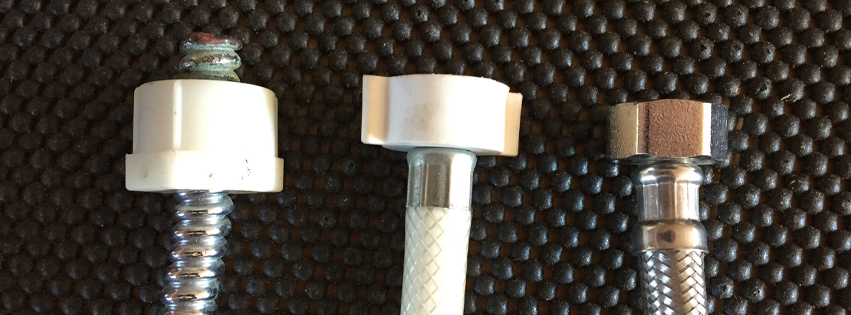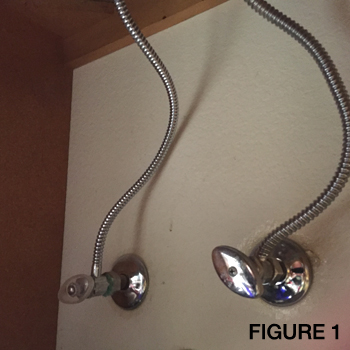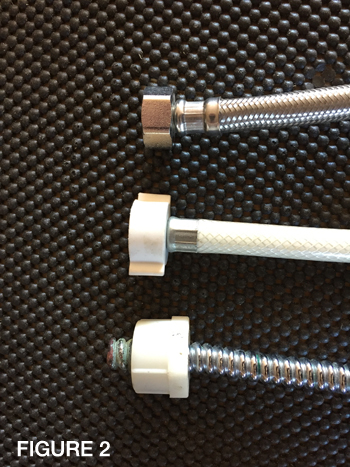Plumbing Tip of the Month: Water Supply Lines
 25 October 2016
25 October 2016 

 Every toilet and sink in your home has water supply lines that connect into the home’s fresh water system. Every toilet has one supply line and every sink has two – one for hot and one for cold. Inspect your home and replace older, out-dated water supply lines sooner than later. Here's why:
Every toilet and sink in your home has water supply lines that connect into the home’s fresh water system. Every toilet has one supply line and every sink has two – one for hot and one for cold. Inspect your home and replace older, out-dated water supply lines sooner than later. Here's why:
Older homes used somewhat flexible all-metal/copper lines (Figure 1) when they were originally constructed. These lines are ridged and can be challenging to work with during install and maintenance. They also wear out easily and/or can kink if you’re not especially careful when handling them. If you look under your sink or toilet and see these types of lines, you’ll want to target those lines first for changing.
When replacing these water supply lines, you’ll want to use braided steel lines with brass nuts. (see Figure 2, top supply line) The braided steel lines are so much easier to work with, don’t kink and the brass nuts are much stronger and provide an extra level of protection.
There are some braided supply lines that have plastic nuts (Figure 2, middle and bottom supply lines). We’d like to warn you to NOT use those at all. They are a huge false sense of security, as the plastic is much weaker and can burst. If they burst while you’re at work, or even worse while you’re on vacation, you’re going to come home to an awful mess and lots of water damage.
Keys to Success for this Plumbing DIY Project:
- Water Shut-off Valve: Be sure to turn off the main water line outside your house BEFORE you begin.
- Drain your whole home’s water lines: Once you’ve shut off your homes water line, go to the lowest faucet in your home and open it to drain the water from the pipes.
- Once you’ve removed and replaced your lines, be sure to thoroughly test for drips and any leaks.
Key Supplies:
- Small bucket for draining and catching drips
- Plumbers Teflon tape o Wrenches and possibly channel locks
- Rags/towels for any spills and cleanup
###
Related Content:
- Plumbing Maintanence: What other areas of my plumbing should be maintained.
- In this Rosie on the House Three-Minute Tip, Linda Stanfield from Stampede Plumbing, now Day & Knight Plumbing and Rosie plumbing tools every DIY'er should have - and a must-know tip for your faucets and toilet water supply lines.
Key search terms: plumbingtip plumbingtips plumbing tip
Print this page
recent post
- Duck, Duck, Duct! How Often Should Ductwork Be Cleaned?
- Vinyl vs. Fiberglass Windows: Which Is The Better Choice Of Replacement Window?
- We May Be The Grand Canyon State, But The Rocky Mountains Are Important For Arizona
- Welcome to Arizona! Things A Newbie to Arizona Should Know
- The Pros & Cons of Buying A Flipped House
- Getting In On The Ground Floor
- Why It’s More Critical Than Ever To Get Your AC Serviced Before Summer
- The Reality of Remodeling
- What To Look For When Comparing Your Roofing Quotes
- What To Expect When Buying New Windows & Doors
